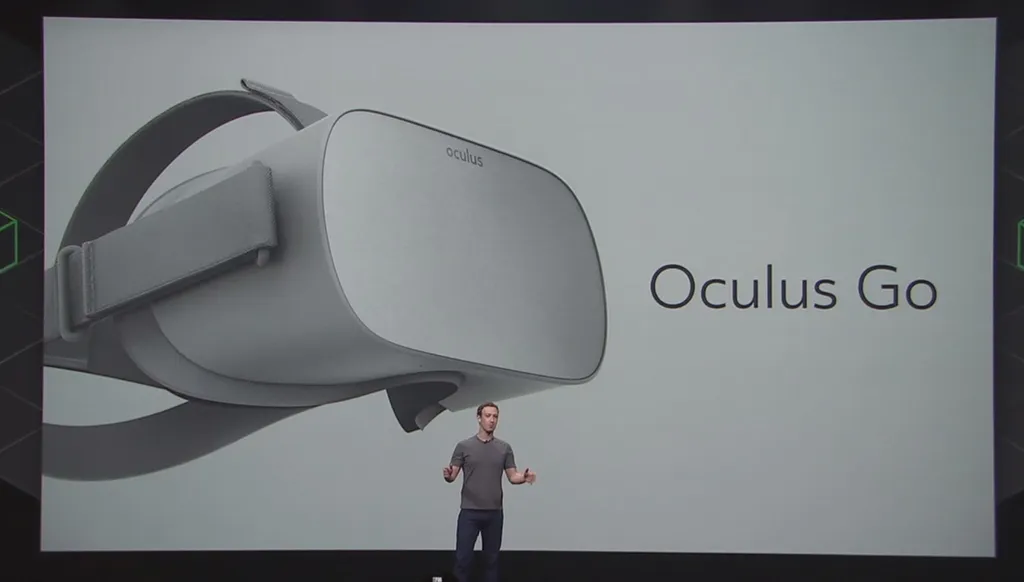Facebook is betting its $200 Oculus Go VR headset represents VR’s breakthrough moment, opening up the market to millions more people and catalyzing the adoption of VR as the next platform for personal computing.
Microsoft and Google aren’t messing around with VR. Those established tech giants are very serious about this new Medium. But with Oculus Go we see Facebook’s focus on a fresh start for immersive computing — and Mark Zuckerberg’s visionary $3 billion bet on Oculus in 2014 — begin to become apparent.
Price
$200 is a shockingly low entry price for high quality VR.
Before Oculus Go was announced at OC4, the all-in cost for getting a high-quality VR system was arguably set by Sony’s PlayStation. $400 for the headset and its tracking camera plus $300 for a PlayStation 4 put the all-in cost around $700.
If you get Google’s Pixel 2 the price starts at $650 with another $100 for the new Daydream View.
Oculus Go cuts the entry point for high quality VR in 2018 to 1/3 what it was in 2017.
In an interview with Nate Mitchell, an Oculus co-founder and now VR product executive at Facebook, he called back to Kindle and iPod in noting consumer electronics inflection points were achieved when those gadget families were driven to lower prices. Oculus Go represents Facebook’s first attempt to turn that corner and bring VR to millions of homes.
“We make the most accessible VR device bar none,” Mitchell said.
Frictionless VR
Oculus Go also solves perhaps the biggest issue facing VR — friction. The time and effort between when you want to enter VR to the time you are flying through a virtual world will be dramatically reduced with Oculus Go.
Google currently leads the market here with a headset that easily aligns with a phone as you place it in the lightweight Daydream View. This is a good start, but even the act of placing it in a phone holder, waiting for the VR mode to boot, then waiting for the world you want to load is still tremendous effort compared with watching TV or looking at Facebook on your phone, and it keeps people from entering virtual worlds all the time. Critically for the developers believing in VR since the Oculus Kickstarter in 2012, all this friction keeps people from spending money in VR.
For comparison’s sake, entering VR with a PC or console is a goddamn nightmare. Get the headset out, turn on the console or PC, turn on the tv, plug in the headset, adjust the cameras and pray there isn’t a software update.
You can eliminate some of this friction with some VR headsets but it’s generally a shitshow with all the wired systems. The number of steps between wanting to enter VR and actually getting to a place where you can do something interesting is enormous when compared with Google’s Daydream.
With Oculus Go, visiting a virtual world will become as easy as using your phone, tablet or TV. If the price is critical in making VR reach an inflection point, this frictionless experience is at least as important for quicker adoption of VR.
Hope For Struggling Devs
I’ve been closely tracking the VR market and the financial health of developers who’ve invested enormous time, love and faith in this burgeoning medium and the software they’ve been building for it over the last several years.
Oculus, major movie and television studios and some brands are funding the creation of virtual worlds and 360-degree videos. These projects are keeping some VR-focused studios and startups fully staffed and their families fed. But there’s another type of VR content — that of independently produced highly interactive virtual worlds. Some of these are coming from lone developers or teams of less than eight who are producing for Vive, Rift and PS VR and pricing their software between $10 and $50. Some of these projects have cleared $1 million in sales, and more are seeing modest figures but enough to work on further VR projects.
I’ve heard of no such $1 million+ projects in mobile VR, and generally fewer stories from developers who are able to support themselves from sales of their software directly to consumers.
This is despite the fact that, on paper, the Gear VR’s more than five million headsets in the market makes it the biggest high-end VR platform. You could try counting cardboard boxes, which would outnumber Gear VRs, but I’d argue the experience is so terrible people are even less likely to spend money on something for Cardboard than for Gear VR.
This is all to say that developing for mobile VR over the last three years has been tough. There are a variety of factors driving this situation, but it all stems from a general reluctance among consumers to buy software on mobile phones. Free to $3 is the price range for most mobile phone software, and a $10 virtual world just doesn’t fit in that universe. Many Gear VRs were given away free with the purchase of Samsung phones, suggesting many don’t even use the device and those that do may not see the point in buying software for something that is being handed out as if it was disposable.
Spending $200 up front for Oculus Go will likely change that dynamic entirely. A standalone VR headset is psychologically separate from the phone market. People bringing the headset home are investing in something, like a Blu-Ray player or game console, that invites buyers to spend more money.
For mobile VR developers, this means that with the prospect of Oculus Go on the horizon, the light at the end of the tunnel is no longer a fast approaching train. That light may finally be from a brave new world.




























